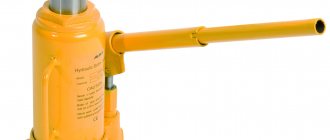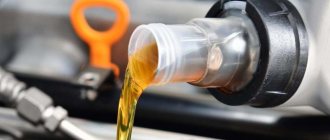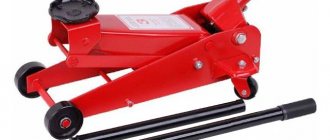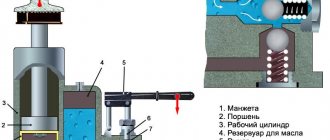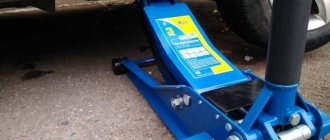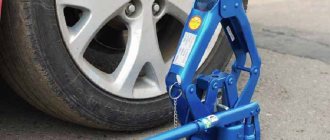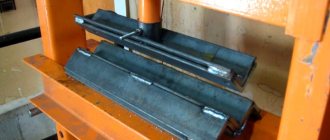Sometimes problems arise with hydraulic jacks. Most people throw them away immediately. But don’t throw it away, maybe the problem isn’t that big.
But it happens that the jack does not raise it to the required height. Previously, for example, the length of the rod was enough to lift the car, but now it is not. It rises halfway and that’s it. Oil is to blame here. More precisely, its lack.
When a working jack works, oil is still consumed. Quite a bit, but it is used up with each rise/fall. For good reason, it should be changed from time to time - about once a year. But who does this kind of nonsense here?) Usually it works as long as it works)
In general, two of my jacks malfunctioned. One is rolling, the other is bottle-type, both are hydraulic, of course. A rolling jack is the same as a bottle jack, only installed in a special design. After I raised the car, they slowly lowered it. I decided to add oil.
In general, it is recommended to add special hydraulic oils to such jacks. You can go and buy it, you can fill it with spindle oil, which is also hydraulic. Or you can, at your own peril and risk, top up with regular engine fuel. Which is what I did. This, of course, is not recommended, the properties of the oil are not the same, but oh well
.
First you need to lower the jack completely. We unscrew the fitting, lower the rod (or the lifting part of the rolling part), and screw the fitting back. We find the hole through which the oil is poured. It is closed with a rubber plug.
Without a jack, a car enthusiast, without exaggeration, is left “without hands.”
And it is needed not only to change a tire on the road. A good jack is indispensable for some types of repair work - especially in a regular garage that is not equipped with a lift. For example, when assembling the suspension after repair, when it is necessary to make the final tightening of the levers. There is absolutely no need to lower the car onto the wheels so that the silent blocks take the “working” position - just jack up the lever to give it the desired position. A rolling hydraulic jack is especially convenient - thanks to its design, it can be installed under a part located low - so that no other jack can get under it. But, like any other mechanism, the jack can fail. Repair of a rolling jack is available to anyone who repairs a car themselves. We’ll just tell you what you need to pay attention to first when repairing a rolling jack with your own hands. First of all, let's look at its device.
About repairing a rolling jack with your own hands
Today, almost every driver, both experienced and beginner, has a jack.
This device is designed to lift a heavy load to a certain height. But in most cases, motorists use the mechanism to carry out installation work during vehicle repairs. The most popular is the rolling hydraulic jack, which is considered an indispensable tool, since its presence is mandatory in every large car service center or workshop. But sooner or later, the operation of any mechanism becomes unstable, and in this case you need to know how to properly repair a rolling jack.
Hydraulic rolling jack
Tags
Hydraulic jack non-hydraulic jack hydraulic jacks anyhydraulic jack hydraulic jacks arrangedhydraulic jacks have lifting jack.transporting jack.hydraulic jack not working jack hydraulichydraulic rolling jackversions of bottle jack.bottle type jackhydraulic bottle useful Hydraulic hydraulic jackworking hydraulic jackbreaking hydraulic jacks does a hydraulic jack work what do hydraulic jacks do parts of a hydraulic jack bottle hydraulic jack why does a hydraulic trolley lifts hydraulic jack.
car handsoperation
Design and principle of operation of a rolling jack
The design of a rolling lift is somewhat similar to a trolley on wheels, which allows you to fit and use the mechanism to repair any car. This lift model is distinguished by the presence of additional attachments, which increase the possibilities of its use several times.
Metal is used to make the lift body, after which it is mounted on two pairs of wheels. Mechanisms are pre-built into the jack body, with the help of which the vehicle is lifted, as well as a hydraulic cylinder, which, in a retractable position, provides support and lifting of the working platform. Due to the fact that the platform rises, the load will be lifted to a certain height level.
With the help of a lever, the hydraulic trolley jack can be easily moved. To lower the platform, use the handle to turn the screw, which will open a spare sample of a special valve. As a result of the oil pressure being released in the working cylinder, the vehicle will lower to the desired level.
Professional and industrial use involves the operation of various models of rolling mechanisms capable of lifting and securing loads weighing more than 20 tons.
Design of a rolling jack
What elements does the device of hydraulic jacks include?
Table of characteristics of jacks.
The lever of the device activates the pump, which pumps hydraulic fluid into the cylinder through a special valve. Hydraulic or working fluid is the oil that is squeezed out in the cylinder. The jack is lowered back down with the valve located on the pump open to allow hydraulic fluid to flow into it.
Using hydraulic jacks is easy. They must be located on level ground underneath the vehicle. After closing the valve of the device, its lever is pressed until the car is raised to the required height from the surface.
To lower the car back to the ground after the tire has been replaced, the valve opens smoothly counterclockwise. When the device is in its original position, the valve is closed back by turning it in the opposite direction.
How to bleed a jack correctly
Operating principle of a screw jack.
The jack, like any mechanism, requires periodic inspection and maintenance. Liquid can be added to the cylinder, since the use of the device is associated with oil leakage through the seals and oil seals. When using a jack to repair a car, use a safety stand. By adjusting the device with it, you can prevent the car from falling to the ground if the jack is faulty.
Storing the device in places where there is high humidity leads to rust on the cylinder. For the same reason, the working cylinder can become unusable. However, the disadvantage of a hydraulic jack is its slow operating speed and low lifting height. Some models have quite a large dead weight, so transporting it in the trunk is not very convenient.
Causes of rolling jack breakdowns and tools required for repairs
Specialists who have experience in repairing hydraulic lifts recommend purchasing a jack repair kit for such purposes. Be sure to have wrenches, special flushing fluid, high-quality oil and other spare parts for hydraulic rolling jacks on hand. You also need to first prepare a container in order to receive the drained working fluid.
Any tool can break when used over a long period of time. The list of main malfunctions of the rolling structure includes:
- leakage of working fluid (i.e. oil);
- when raising or lowering the rod, the device may completely fail;
- When lowering or raising the car, the device partially jams.
If the working fluid leaks, the lift must be completely disassembled, then the adapter and pistons must be removed from it and carefully inspected for corrosion. If contamination and signs of corrosion have been identified, all elements of the mechanism must be cleaned, dirt removed and the rod checked. If the rubber rod is deformed and bent, it will not be practical to repair it.
Another common cause of hydraulic jack failure is a clogged or damaged washer in the main part of the device. The fact is that only with the help of the valve can you hold, lower and raise the working rod of the structure, and if its malfunction is detected, it is recommended to immediately resort to repair work or contact service.
Required tools and materials
You can repair a hydraulic jack yourself in your own workshop if you have the required materials and tools. It is worth considering that some versions of the lifting mechanism are represented by non-separable structures, and it will be quite difficult to carry out repair work. The hydraulic jack should be disassembled taking into account its design features. To do this you may need the following tools:
- Hammer and chisel.
- Pliers.
- Screwdrivers of various diameters.
- Hacksaw.
- A set of keys and a gas wrench.
There are simply a huge number of varieties of hydraulic jacks, so it’s difficult to say exactly what tools you might need to get the job done. In some cases, it is possible to easily access the internal mechanism for maintenance or repair; in others, disassembly will take quite a lot of free time.
Air bubbles and troubleshooting
As for the operating efficiency of a hydraulic rolling jack, in most cases it is reduced due to the fact that air bubbles accumulate in the main cylinder. The formation of bubbles can be caused by an insufficient amount of liquid in the working cavity.
Before carrying out repair work in such cases, you must first unscrew the plug in the oil tank and remove the bypass toggle switch, after which you can begin bleeding the mechanism pump. This is necessary so that air bubbles move from the cavity into the liquid container. After the bleeding procedure, the tank lid and the bypass valve are closed; if all operations were performed correctly, the jack will function normally.
Pumping oil into a hydraulic lift
Experienced professionals recommend using another common method to remove air bubbles from the jack. To do this, the locking needle must be unscrewed no more than 2 turns, and the plunger must be lifted to the extreme point using your hand. After raising the toggle switch, after a certain period of time it will return to its lowest position. It is worth noting that the procedure often needs to be repeated 2-3 times, and in order to prevent air from accumulating in the working system of the lift, it is necessary to control the volume of working fluid during its use. If there is not enough oil, it should be added, while monitoring the quality, and also change the cuffs for the rolling jack in time.
To prevent unwanted breakdowns of Chinese hydraulic lifting mechanisms, when they are used intensively, it is imperative to replace the working fluid and ask yourself why the rolling jack does not lift under load. It is worth remembering that if the oil level drops, it should be topped up, and then the entire structure should be pumped. Before starting repair work, you must definitely study the manufacturer’s recommendations, which are indicated in the technical data sheet attached to the jack. Otherwise, if you ignore all the recommendations, you can provoke premature failure of the tool without the possibility of further restoration.
Source
Recommendations
To increase the service life of the jack, it is advisable to follow the following rules.
- The lifting device oil must be changed twice a year. If the hydraulic jack is used every day, then it must be replaced at least once a month and must be washed.
- Any replacement oil can be used . But for the winter season, it is advisable to fill exclusively with synthetic types of oils.
- To prevent the lubricant from thickening in winter, the jack should be kept in a dry and warm room.
- When lifting work is carried out in winter, it must be remembered that if the device is used for a long time in severe frost, it can become unusable. In this regard, it is recommended to work with it in the most extreme cases and for a short time.
The ideal “repair” of a lifting device is preventative work to prevent breakdowns, in other words, continuous maintenance and timely replacement of the working fluid with pumping. Since eliminating any malfunction will require spending personal time, and sometimes some money. In this regard, it is necessary to follow all instructions for using hydraulic lifting devices, in which case they will work for quite a long time.
For repairs to a hydraulic jack, see below.
How does a rolling jack work?
The design of the lifting device is quite simple and straightforward, however, before you start working with the device, you should familiarize yourself with the main components that make up the rolling jack. The design and repair of a broken lift will become clearer when considering its components.
The process of a jack (using the example of lifting a car) is as follows. First, the car is installed on a flat, level surface, then the rolling jack, in a deflated state, is rolled under the car. To lift the car, you need to press the handle several times. In this case, a working, serviceable mechanism will raise the car with each press.
Repair and service
Hydraulic bottle jacks
Read also: Why does the timing belt whistle?
In order to service the bottle jack, it must be disassembled. There is no need to worry about being splashed with oil from high pressure. It is quite possible to do this operation yourself. The first step is to drain the oil. Draining is done through the filler hole, and if there is no drainage through the bypass valve, to do this, unscrew the upper hex nut and completely unscrew the lower valve. We remove the housing, check its tightness, and assess the condition of the lower rubber ring. These parts do not carry a load, they are just a reservoir for liquid. Next, unscrew the working cylinder and remove the piston. We carefully inspect everything for rust. If it is found, we get rid of it as thoroughly as possible. We unscrew the plunger, check its functionality, and inspect the O-rings. There should be no iron shavings inside, parts should not have dents. Seals that have become unusable should be replaced with new ones. Do not forget to thoroughly rinse all valves from dirt and various deposits. We carry out the assembly, and all the repairs have been made.
Basic faults
The reasons that lead to the breakdown of the jack may be: accumulation of air bubbles in the main cylinder, insufficient amount of working fluid in the lift, leaky sealing gaskets and cuffs, complete failure of one part of the device. If one or more malfunctions are detected, the rolling jacks can be repaired both in specialized repair shops and in garage (home) conditions.
What to do?
Doesn't hold under load
The lowering of the rod when it rests on the lifted load and sometimes without much pressure happens for 2 reasons: lack of oil or failure of the valves. Let's consider each option separately.
The lack of oil is due to normal leakage due to poor sealing; the jack bypasses oil. As a rule, this is the result of prolonged storage of the jack with the shut-off valve turned off or the wear of the gaskets. The issue can be resolved by adding oil and bleeding the device. It is advisable to use specialized oils for hydraulic systems; at worst, ordinary technical oils will do. If after filling the oil leaks even with the tap tightly closed, you need to buy a repair kit and change all the seals.
Valve failure may be due to contamination of the system or a mechanical defect. There is no need to disassemble the lifting device right away.
It would be wiser to first rinse the channels and internal surfaces that are dirty. For this purpose, drain all the oil from the device and add flushing liquid (gasoline or kerosene will do). It is pumped several times, the used liquid is drained, clean liquid is poured in, and so on 2 more times.
If washing has no effect, you will need to disassemble the jack and inspect the valves. They may not fit tightly due to loose springs or have deformed or worn out balls. The first reason is the most likely and can be corrected by rotating the spring or adding a small washer under it to increase the pressure by reducing the distance to the valve. A worn or deformed ball needs to be replaced.
Doesn't lift well
One of the most common problems is reducing the piston stroke speed to a minimum or idling too much. This malfunction is often associated with a reduction in lift height and a decrease in the maximum load. The main reason for such a problem lies in the airing of the system, which occurs as a result of a decrease in the oil level. Restoring the hydraulic jack to functionality in such a situation is quite simple. To do this, you will need 150-300 milligrams of oil and flushing liquid (if the device is older than 2 years).
First, the shut-off valve is loosened one turn from the tightened position. Then the pump rod is lowered, the stop is all the way to the end.
The plug on the fill hole is unscrewed or removed (if it is made of rubber), and the used oil is drained. When the device is many years old, it is possible that its channels and the surface inside are clogged with dirt, which can be an equally significant reason why the jack does not lift well. It needs to be washed, it wouldn't hurt to wash it several times.
For this purpose, you can use gasoline or kerosene. The liquid is poured through the drain hole, the tap is closed, the piston is raised by pumping the pump, the tap is opened, the piston is lowered, the process is repeated a couple of times. After the loaded liquid is drained, a new portion is poured in and the above procedures are repeated at least once more (you need to focus on the cleanliness of the drained liquid). After cleaning the system, you can fill it with oil.
Before filling with oil, the piston with stop must be lowered to the bottom position and the tap must be tightened. The bottle-type device must be placed vertically during the filling process (it is poured in a horizontal position in the rolling ones). It is more convenient to fill the jack using a syringe until the oil fills the entire container and begins to flow from the hole.
Doesn't go down
A situation that occurs infrequently, but is still significant for many, involves the rod getting stuck in the raised position. When the rod of the device comes out and does not sit in place, two reasons need to be considered: a clogged stopcock or a bent rod. The latter is usually caused by a mechanical defect - from lifting loads exceeding the permitted weight. In such a situation, the only option is to replace the element.
In addition to bending, rust can form on the rod and surfaces inside the cylinder due to prolonged exposure to unsuitable conditions (dampness, a turned-off tap, with the rod raised). Parts can be restored through complete disassembly and cleaning of corrosion.
When the jack does not release, however, the rod rotates freely in a circle, which means there is a snag in the shut-off valve.
It looks like a small foreign object got into the hydraulic jack while pouring oil. During pumping, it ended up in the cylinder, and when the rod was immersed under the influence of force, it clogged the valve channel. The easiest, but not very sure choice is to turn the tap off completely, widening the channel to the maximum. If you're lucky, some of the oil will spill out and the rod will go down. If not, the jack must be disassembled to reach the base of the cylinder and remove the blockage.
Repair of rolling jack
Problems in operation or complete breakdown of the mobile hydraulic lifting mechanism among private car owners make them wonder how to repair a rolling jack. This depends on the symptoms of the malfunction and the results of examining the internal parts of the device. For proper repairs, you may need to disassemble the device in order to inspect it for breakages, foreign objects and other malfunctions.
Refilling and bleeding the rolling jack
When the normal operation of the jack requires periodic removal of air bubbles from the cylinder of the lifting device, the most effective (preventative) method of solving the issue will be to maintain a sufficient level of working fluid in the mechanism. To do this, you need to regularly check the oil level and add it if necessary. As soon as it becomes clear that the problem of excess air in the cylinder already exists, bleeding is required. This procedure is carried out as follows:
- Unscrew the oil tank cap.
- We pump the mechanism using a pump (this will allow air bubbles to escape from the cylinder into the oil reservoir).
- Add oil to the maximum.
- Close the tank lid and check the operation of the lift.
If during inspection any remaining air bubbles are found inside the jack, the procedure for removing them should be repeated.
You can choose another way to correct this misunderstanding. It consists of unscrewing (loosening) the shut-off valve 2 turns and lifting the plunger manually. As a rule, after some time it returns to the zero position on its own. For results, this simple procedure should be carried out several times.
Replacing seals
- To remove the hydraulic cylinder, you will need to unscrew the two large mounting bolts located on the sides of the device: one pair in the middle, the second pair at the edge.
- Remove the spring using a screwdriver or other hook.
- Remove the plug and drain the old oil.
- Disassemble the hydraulic cylinder using suitable wrenches, after securing it securely (preferably in a stationary vice).
- When the inner part of the cylinder is disassembled, you need to remove the cuff from it.
- Clean the valves, pump and inner surface of the cylinder by wiping with a rag soaked in kerosene.
- Install new seals on the piston and plunger.
- Reassemble the jack in reverse order using new seals.
After assembly, you should fill the system with oil and remove air according to the instructions above.
Valve restoration
When a jack breaks down and it cannot lift a load, the reasons are often the presence of a foreign object inside the device or deformation of the valves. The instrument should be disassembled for inspection. We remove the spring, unscrew the fasteners, remove the hydraulic cylinder and disassemble it (drain the oil in advance). First of all, we remove the throttle, pressure supply valve and bypass. We take out the balls and check for integrity, and the holes where they were located for contamination (we replace broken ones, clean dirty ones).
How to extend service life
- If you do not use the jack for a long time, it is recommended to periodically bleed the hydraulic system (at least once every 3 months). In this case, you will prevent the formation of corrosion and jamming of the piston.
- Remember to lubricate the rod with a light grease. This way you will significantly extend the life of the tool. It is also necessary to wipe the jack from dirt and dust, and inspect all parts (especially for oil leaks).
- If you do not plan to use a jack, the support part should remain completely lowered. Otherwise, over time it may begin to rust.
- Add hydraulic oil occasionally. Manufacturers do not recommend mixing oils of different brands.
- Once every 2 years, you need to completely flush the hydraulic system from dirt and small particles. It is also recommended to change the O-rings and cuffs.
- If you do not use the jack, you should store it in a dry place at above-zero temperatures.
Now you know how you can independently eliminate the main problems in the operation of a rolling jack. Follow the operating instructions and the hydraulic tool will serve you for a very long time.
Save this page on your social media. network and return to it at any time.
Modification of the rolling jack
Modifying the jack can be useful if you need to lift a load to a greater height, exceeding the factory specifications of the device. Also, modifications can quickly and easily solve the safety problem of the lifting mechanism. This can be solved by installing a clamp in the jacking platform. Both easy upgrade options are explained and shown below.
Increasing lift height
The low lift height may limit the jack's range of use for vehicles with high suspension. In such situations, tool owners may be interested in knowing how to increase the height of the rolling jack. A simple stop extension can be made from scrap materials. The guide below uses a brake cylinder from a Zhiguli, but you can use a regular thick-walled pipe of a suitable diameter.
First of all, you should prepare the adapter by welding a transverse plate to the top of the pipe in which you need to drill a hole for fixing (with the standard diameter).
Next, unscrew the bolt to which the thrust bowl of the rolling jack is attached. We remove the stop from its place and place an extension on it, with the drilled plate facing down. We place the previously removed bowl on top of the structure. We take a long bolt the diameter of the holes, thread it through the thrust bowl and pipe, and then tighten it with a nut.
Such jacks, with useful modifications in the form of increasing the lifting height, become useful for lifting SUVs and minibuses. At the same time, the added part (cylinder) remains a removable part of the mechanism, because it can be removed if necessary by unscrewing the bolt back.
Installing the retainer
So that when lifting the car you do not have to install an additional support to securely fix the car, a small modification of the rolling jack is required, which requires a minimum of time and materials.
We drill one 14 mm wide hole on both sides of the jack (approximately in the middle, opposite the central part of the rising piston mechanism of the jack).
We take a steel rod Ø 14 mm (we used a hinge rod for a rotary connection) with a pre-cut thread and a nut of the appropriate size for it. We raise the jack and fix the lifting part of the mechanism by inserting the kingpin into the holes made in the middle. Secure with a nut.
After these changes, the kingpin inserted into the jack will prevent the lifted car from lowering in the event of a sudden breakdown (failure) of the jack due to the opening of the exhaust valve. A more visual representation of this modernization is demonstrated in the following video.
Source
Data protection
The company carries out effective multi-level work to protect clients’ personal data and the security of financial transactions in the system when working from a PC or mobile device. Provides services to protect clients from hacking and information theft:
- high-quality certified protection of web services and hosting (official certification has been passed for compliance with data security conditions);
- protection against DDoS attacks for clients of different levels of use: from corporate companies to individuals (IP addresses are protected around the clock by ARBOR equipment and other security systems);
- protection of financial transactions and personal data: encryption, confirmation by SMS code, and notification of changes via SMS alerts. To use this convenient service, registration is required, but it will not take much time and will save time later. If you have any questions or problems with registration, please contact your online consultant. Make your life more comfortable by making room for what’s important, entrusting your routine to reliable specialists and proven systems!
It is worth noting that if any problems or questions arise regarding interaction with your personal account, the company’s subscribers can contact the Hotline.
Why won't the jack go down or up?
Reasons why the jack refuses to work:
- Cylinder failure. The working plane does not support the load; as a result, liquid flows from the cavity into the space above the piston.
- Damage to the mirror. Hydraulics lose efficiency or simply fail, this occurs due to improper transportation, it can lead to oil leakage and air entering the chamber, in which case corrosion will certainly begin over time.
- Corrosion. Leads to rapid wear of the cuffs and seals, which may result in dirt getting into the liquid and clogging the channels and valves.
- Unit fall. The greater the height from which the jack falls, the more serious the deformation of parts and main components can be.
- Too much load. Causes the rod to bend. This leads to misalignment of the main components and oil leakage.
- Use of the device for purposes other than its intended purpose, as well as failure to change the oil in a timely manner.
Rod curvature
Jack operating diagram
Professional rolling jacks differ in size and load capacity. As a rule, the valve is controlled by turning the handle, which is very convenient during operation. But the principle of operation of all hydraulic jacks is the same, so it is more convenient to use the diagram - after all, despite the size and type of products, they have the same causes of breakdowns.
Rolling jacks differ in size and load capacity. Typically, the valve is controlled by turning the handle.
The force created by the plunger is transmitted through the oil used as the working fluid to the piston connected to the rod. In this case, oil is pumped from the front cavity of the jack cylinder to the rear cavity (from the plunger side). The bypass channel is closed, and the inlet and discharge valves allow the oil to move only towards the rear cavity, that is, the jack works like a pump. When the bypass needle (which is a pointed threaded rod) is opened, oil can flow back into the front cavity through the bypass channel. If at this moment the jack is under load, the piston rod will sink into the cylinder. The performance of the jack is ensured by compliance with three conditions:
- Tight fit of valves to seats.
- Required oil level.
- No air bubbles in the oil.
Types, properties and characteristics of hydraulic bottle jack
Jacks are divided into several types, the first division is based on the number of rods (half-rams):
- Single-stem bottle, the most common type Fig. 2.
- Double stem bottle Fig 3.
There is also a division based on the operating principle of the pump pumping liquid:
- Manual, activated by user pressure on the lever
- Large pumps designed to lift enormous masses are driven by a separate drive, hydraulic pump or hydraulic station.
Properties:
Load capacity , an important parameter that determines the maximum lifted weight. The parameter depends on the volume of the working chamber and strength characteristics. Bottle-type devices have a load capacity from 2 to 100 tons.
Minimum lifting height , otherwise called minimum pick-up height. This is the height at which the load must already be in order to be able to place a jack under it. Please pay attention to the minimum height if you are selecting a device for a car. If you have low ground clearance, then a bottle-type device due to its high design will not suit you.
Some final tips
The performance of the jack depends on the quality of the lubricants that are poured into it. You should not skimp on oil, as this can lead to serious damage that will not be repairable in the future. If the device will be used in various conditions with temperature changes, it is better to fill the jack with a frost-resistant synthetic lubricant, which will preserve the functionality of the system.
In winter, it is better to refrain from using the device for a long time in the cold, since all gaskets and seals are very sensitive to low temperatures.
